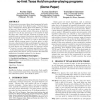920 search results - page 162 / 184 » Applications of Simulation to Social Sciences |
ATAL
2007
Springer
14 years 1 months ago
2007
Springer
Norm-governed virtual organizations define, govern and facilitate coordinated resource sharing and problem solving in societies of agents. With an explicit account of norms, openn...
ATAL
2008
Springer
13 years 11 months ago
2008
Springer
We demonstrate two game theory-based programs for headsup limit and no-limit Texas Hold'em poker. The first player, GS3, is designed for playing limit Texas Hold'em, in ...
AAAI
2006
13 years 11 months ago
2006
Voting (or rank aggregation) is a general method for aggregating the preferences of multiple agents. One important voting rule is the Slater rule. It selects a ranking of the alte...
ESA
2010
Springer
13 years 10 months ago
2010
Springer
We study the problem of estimating the average of a Lipschitz continuous function f defined over a metric space, by querying f at only a single point. More specifically, we explore...
SIGECOM
2010
ACM
13 years 10 months ago
2010
ACM
Cut games and party affiliation games are well-known classes of potential games. Schaffer and Yannakakis showed that computing pure Nash equilibrium in these games is PLScomplete....

